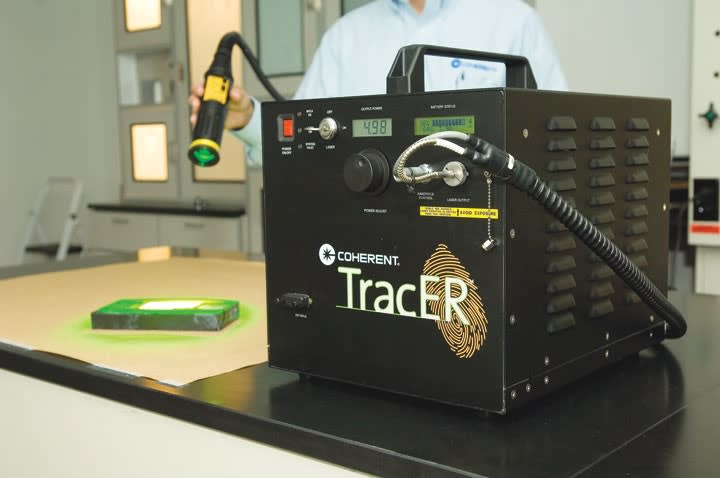Obviously, these devices were only used by the largest agencies because of their cost and size. Times have changed. Today Coherent Inc. offers a state-of-the-art fully portable forensic laser light source for under $50,000. Still a large sum of money, but much more accessible to a larger number of agencies.
Forensic Light Source Basics
A forensic or alternate light source is a device that outputs a specific wavelength or color of light. Many light sources are capable of outputting many different wavelengths of light, from ultra-violet, through the visible spectrum and into the infrared region. Some materials fluoresce when this colored (or UV or IR) light is applied. Biological fluids (semen, urine, saliva, vaginal fluid, blood, etc.), fingerprints, hairs/fibers, bone fragments, and chemical accelerants are just an example of the many types of evidence that can be located using forensic light sources. Each particular type of evidence responds best to a specific wavelength of light. Generally speaking, the range from ultraviolet light to green light is the most useful for locating evidence and processing fingerprints. In order to see the evidence, all light sources are used with barrier filters—goggles and/or photographic filters. The barrier filter blocks the colored light from the forensic light source but allows the light from the fluorescing evidence to pass through so it's visible.
Many different forensic light source technologies exist, including laser-based systems, lamp-based systems, and LED- (light emitting diode) based systems. All of these different technologies have their strengths and weaknesses. In my experience, most law enforcement agencies around the country that utilize forensic light sources are using a xenon lamp-based system. These include Spex CrimeScopes, Rofin Polilights, and the OmniPrint from OmniChrome. Smaller handheld LED light sources are becoming more popular because of their low cost and high portability. I have personal experience with lamp and LED forensic light sources, but I had never had the opportunity to use a laser light source until earlier this year when Coherent delivered a TracER for evaluation.
Coherent and the TracER












